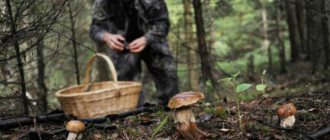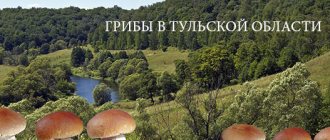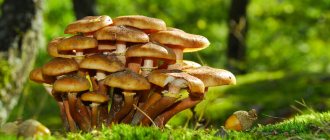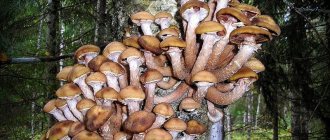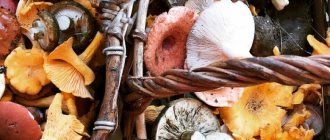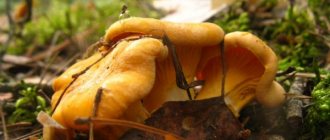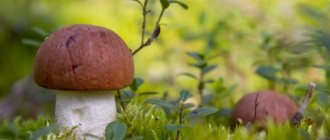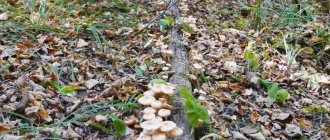The Krasnodar region is distinguished by an abundance of mushrooms, and a wide variety of them. The myceliums here are not subject to drought, which means they produce a large harvest. They can be collected from the very beginning of spring until the very first frosts, which occur here in November. In the Krasnodar region you can find oyster mushrooms, hornbeams, honey mushrooms, champignons and others. However, we should not forget that their poisonous or inedible counterparts also grow here.
Some types of mushrooms even grow in gardens, of which there are many. In this case, you don’t even need to go out into the wild, but just drive a few kilometers from the city.
Map of the Krasnodar region.
Mushroom map of the Krasnodar region (Kuban)
The peak of the season depends on the summer: if it was first hot and then rainy, there will be a lot of mushrooms in the forests. Autumn brings rain, after which many people flee to the forests. But mushroom pickers are in no hurry to collect: the first to emerge “into the light” are the poisonous doubles. Mushrooms are most often collected in the Krasnodar region. There are many foothill forests, ravines and fertile meadows. They are most often sent to the following places:
- Absheronsky and Tuapse districts: chanterelles are collected here. Oyster mushrooms and some russula also grow here.
- In the Mostovsky district in the vicinity of Psebay: places are rich in honey mushrooms; they are collected from July until the first ten days of December. Chanterelles are less common (near the village of Zelenchukskaya). Here you can also find rarer specimens of yellow hedgehog.
- the villages of Kaluzhskaya and Smolenskaya: white and boletus are often found not far from them.
- Goryachy Klyuch, Arkhyz region (between Lake Kardyvach and Krasnaya Polyana): honey mushrooms bear fruit well in this area. They are collected at any time of the year (except for the snowy months of winter).
- the villages of Dakhovskaya and Smolenskaya, the villages of Shabanovka and Fanagoriyskoye: milk mushrooms grow abundantly.
- Goryacheklyuchevskaya and Absheronsk districts: here, as well as near the coasts of Gelendzhik, Sochi, Tuapse, boletus and aspen boletuses are searched for in the mountain forests.
- the mouth of the Ubinka River: the oak forests growing here are rich in oak trees.
The Crimean and Seversky regions are also considered favorable. Honey mushrooms are “hunted” in the vicinity of Krasnaya Polyana and in the territory of Goryachiy Klyuch. They get to their destinations using railways and minibuses. It is better to travel to remote areas by car.
When do autumn honey mushrooms appear in the Urals?
In the Urals, honey mushrooms are collected when the weather is warm and there is heavy rain. This is around the end of June - beginning of July. Residents of the Urals call honey mushrooms “forest bread”, since it has no equal in cooking - it is universal. You can eat it in any way, but not raw. And Russian cuisine is replete with recipes for preparing honey mushrooms. We invite you to look at photos of honey mushrooms growing in the Urals:
It is worth saying that honey mushrooms are very rich in vitamins and microelements that are beneficial for the human body. Autumn honey mushrooms are especially valued, appearing in early September and continuing to grow until the first frost. Autumn honey mushrooms in the Urals are considered the most popular among the local population. And the Ural territory itself is rich in the number and variety of mushrooms. The season for collecting honey mushrooms in the Urals depends on what the weather is like in the region.
When honey mushrooms appear in the Urals depends on the average daily air temperature. Even if the air warms up to 5-7 degrees Celsius in mid-October, the mushroom season will not stop until November. Even then, many young honey mushrooms can be found in the forest.
Mushroom places in the Krasnodar region
These are the Absheron and Tuapse regions. Oyster mushrooms, different types of chanterelles, russula and other edible species grow in large quantities here. Porcini mushrooms can be found almost throughout the region, especially in forests:
- oak;
- birch;
- pine;
- fir
Many of them are found in the following areas and villages, the vicinity of the villages:
- Saratovskaya;
- Kaluga;
- Smolenskaya.
One of the most commonly found mushrooms in these areas is honey mushrooms. They always grow in large colonies and collecting them is not difficult. Boletus mushrooms can be easily found in the foothills - Goryacheklyuchevskaya, Apsheronsky districts, as well as near the sea - the vicinity of the cities of Gelendzhik, Tuapse and Sochi.
According to local experienced mushroom pickers, the most favorable mushroom places in the Krasnodar Territory are oak forests near the Ubinka River, as well as the Crimean, Seversky, Apsheronsky and Tuapse regions, Goryachiy Klyuch and the outskirts of the city of Gelendzhik. A significant number of milk mushrooms, aspen mushrooms, boletuses, white mushrooms, moss mushrooms, trumpet mushrooms and white mushrooms grow near Tuapse. Here, regardless of skill, there is always the opportunity to collect a rich harvest of tasty and healthy mushrooms.
Such different fly agarics
Even children know about the dangerous properties of fly agaric. In all fairy tales it is described as a deadly ingredient in the preparation of a poisonous potion. It’s so simple: the red-headed mushroom with white spots, as everyone saw it in illustrations in books, is not at all a single specimen. Besides it, there are other varieties of fly agaric that differ from each other. Some of them are very edible. For example, Caesar mushroom, ovoid and blushing fly agaric. Of course, most species are still inedible. And some are life-threatening and it is strictly prohibited to include them in the diet.
Deadly poisonous fly agaric species that pose the greatest danger to humans include:
- Poisonous (red). Grows in forests under birch and spruce trees. The globular cap is most often bright red, although there are also orange varieties. A rich scattering of large growths is visible across the entire surface, however, they are weakly adherent and are washed off after rain. The flesh is dense, white, with a subtle mushroom aroma. The white leg is tall, strong and powerful, with the remains of a cap in the form of flakes (also white).
- Panther (leopard). It lives among pine trees and is distinguished by a characteristic spotted cap of a brownish color with white growths. The pulp is white, watery, and smells like fresh radish. The leg is cream-colored, twice ringed in the lower part, the walls are quite thick, but have a hollow space inside.
- White stinking (often called white toadstool by mushroom pickers). It grows among the hills in deciduous-coniferous forests, is distinguished by the specific white color of the entire mushroom body and the pungent smell of bleach, for which it is named. The surface of the cap is most often shiny, but sometimes large white flakes are visible on it. The long stalk is almost always curved, with a tuberous base.
- Bright yellow (lemon). Grows mainly on sandy soil. The owner of a yellow hat with a smooth skin, sometimes sparse white flakes are visible on it. The light leg is squat and fragile, with a thick ring at the bottom.
When to collect porcini mushrooms in the Krasnodar region
The fruiting season of porcini mushrooms in the Krasnodar region begins in mid-June and lasts until October. And if weather conditions are favorable for growth already in May, then its collection begins much earlier than usual. Even an experienced mushroom picker dreams of finding such a noble mushroom. After all, the size of its cap can reach up to 20 cm in diameter, with a thickness of up to 7 cm. The smell of the porcini mushroom is very pleasant, and it also looks very beautiful and stately. It is considered universal in cooking and is suitable for any processing process.
The white mushroom grows both in small groups and single specimens. Therefore, if you find one such delicacy, look around and look for its relatives. In the Krasnodar region, porcini mushrooms are harvested when constant warmth and light, soft rains begin, thanks to which the average humidity reaches approximately 50%. The oak forests near the Ubinka River are also considered the most mushroom places.
Kuban is a unique region with complex terrain and a variety of climatic conditions, characteristic of several climatic zones. Thus, the mushrooms of the Krasnodar region include many known and previously unknown species, including those dangerous to human life and health. This circumstance allows us to recommend collecting exclusively well-known and guaranteed edible species.
The flora of our planet is incredibly diverse. There are more than one and a half million species of mushrooms alone. However, only a small part of them, called macromycetes, have large bodies. It is these types of mushrooms, visible to humans, that are the object of “silent hunting”. Favorable climatic conditions determine the presence on the territory of the Krasnodar Territory of almost all species of mushrooms growing in the Russian Federation. But not all of them are popular among mushroom pickers. Let's turn to the most recognized, outwardly recognizable and valued species by gourmets. So, more about which ones grow in the Krasnodar region:
The culinary value rating is “average”. Can be used as food boiled, fried, pickled and salted. Suitable as an ingredient for any dishes.
The distribution area is mountain and foothill territories of the Krasnodar Territory (Arkhyz, Kamyshanovaya Polyana, Ilsky village, the vicinity of the Laba River). Favorite places of growth are forest glades, replete with fallen trunks of trees of various species, stumps, and rhizomes of living trees extending outward.
Grabovik
We continue to look at the mushrooms of the Krasnodar region. Autumn is a great time to collect hornbeam.
It has a cap with a diameter of 10 cm, cushion-shaped and prostrate-convex, hemispherical, yellowish-brownish, golden yellow, brownish-greenish, dark brown and brown when aged. The edge is smooth, solid, thick. Completely dry surface, slightly wrinkled, matte.
Leg 8-14 cm long, 0.9-1.1 cm thick, curved or straight, thickened downwards, pointed base, almost cylindrical and thickened in the middle, solid, whitish-grayish in the upper part, slightly darker below, yellowish when aging, scaly-fibrous. The flesh is hard, yellowish or whitish-grayish, turns pink at the break, then turns red (slightly turns blue when young).
Mushroom picking is carried out in the foothills (near the village of Ku-Tais, in the area of the villages of Saratovskaya and Smolenskaya), in a deciduous forest.
Poisonous mushrooms of the Krasnodar region
In principle, learning to distinguish poisonous mushrooms from edible ones is not so difficult. In Kuban, there are mainly three types of very poisonous mushrooms, but in total, over 10 varieties of poisonous mushrooms can be found in our region. And, first of all, this is the pale toadstool, poisonous entoloma (very similar to champignon and russula), false honey fungus, etc., but you can also be poisoned by the usual edible mushrooms if you eat overripe, rotten, wormy, or long-stored mushrooms .
Honey mushrooms that are too young, the structure or color of which is not yet clearly defined, can also be hazardous to health. Edible mushrooms under unfavorable environmental conditions accumulate toxic substances, acquiring toxic properties. This is observed near industrial facilities, highways, livestock farms, with the release of toxic substances into the atmosphere, water, and soil pollution. But in any case, if the mushroom is not familiar to you, then leave it in the forest without touching it.
The most poisonous mushrooms in Kuban are:
- Pale toadstool is the most terrible poisonous mushroom. This mushroom is the most difficult to distinguish from russula or champignon. And the poison content in it is very high. To get a lethal dose, it is enough to eat 30 g. Moreover, the poison from the toadstool cannot be removed either by heat treatment, drying, or freezing.
- Fly agaric - it can be identified by its red or burgundy caps and bright white spots. Toxins act primarily on the nervous system. Fatal poisoning can occur even from small doses.
- Entoloma - this mushroom can often be found next to trees such as oak, birch, beech, hornbeam, and willow. It is usually white, gray or yellow in color and feels like silk. For severe poisoning, it is enough to eat only one small piece, but death occurs after eating several mushrooms.
Honey mushrooms in Kuban
It is important for all mushroom pickers in Kuban to know where they grow. This will help you go mushroom hunting in the right direction in the fall of 2022, when honey mushrooms in the Kuban begin to bear fruit. The main distribution area is considered to be the foothills and mountain areas of the Kuban - the vicinity of Laba, Kamyshanovaya Polyana, Arkhyz. Most mushrooms are found in forest clearings where there are fallen tree trunks or stumps. Autumn species can be found in pine forests. In any case, they prefer moist, damp plantings. The most mushroom places in Kuban where you should go for honey mushrooms: Summer and autumn mushrooms grow in the Arkhyz area (Goryachiy Klyuch), between Krasnaya Polyana and Lake Kardyvach. The Seversky district, Krymsky, Apsheronsky, Belorechensky, and the outskirts of Barabinsk are considered productive.
Large growths are found in the Kuban in the Afips valley, near Tuapse and near Gelendzhik. When will mushrooms begin to appear in the Kuban? To harvest a good harvest of mushrooms, it is not enough to know where they grow. We still need to navigate the deadlines. Summer ones are harvested from the second half of August until October. The more southern part of the Krasnodar Territory begins harvesting in June. When autumn comes in Kuban, honey mushrooms should be looked for from the beginning of September until frost. In more southern regions, the “silent hunting” season begins in August. Mass fruiting occurs in September. Winter ones are not at all difficult to find. They stand out well against the snowy background. Mushroom pickers note that winter honey fungus is slightly inferior in taste to its summer-autumn counterparts.
Honey mushrooms in Kuban.
But you can collect fruiting bodies in December, January and February. If the temperature drops below 0 °C, the mushrooms stop growing. As soon as warming occurs, they appear again. Collection rules Mushroom pickers need to preserve the mycelium so that honey mushrooms can grow again. Following the basic rules for collecting fruiting bodies will help with this: Fruiting bodies are cut, not pulled out. You can unscrew it if you want to avoid contact of the mushroom with the metal. This method is preferable. Immediately clean the cap of debris and place it in a basket on its side or with the cap down. Young specimens are selected. Mushrooms are looked for in old forests, especially in plantings older than 30 years. It is recommended to collect in a basket, not in buckets.
This will keep the mushrooms fresh longer. Read also: Where to add dried barberry How to find out if honey mushrooms have appeared in the Kuban There are mushroom years and non-mushroom years. This is the name of the season in which there is almost no rain and humidity. You need to start collecting honey mushrooms in the Kuban when warm, rainy weather sets in. Moist soil is the ideal condition for mycelium germination. After a good rain, after 5-6 days you need to go on a “quiet hunt”. A good reference point for a mushroom picker will be a fallen tree or a stump covered with moss.
Real chanterelle in the Krasnodar region
The cap is 3-9 cm in diameter, up to 1.3 cm thick, convex, depressed in the middle, periodically funnel-shaped. The edge is bent down, wavy, solid, thin. The mushroom is yellow-egg-colored. The surface is dry, smooth, matte, bare, the pulp does not separate from the skin. Fresh taste, pleasant mushroom smell. It is almost never affected by larvae. Hymenophore in the form of branched veins running down the mushroom stalk. The veins that replace the plates are narrow, thick in places, in the form of folds, very sparse, and are not separated from the pulp.
The leg is curved or straight, thinner in the lower part, passes upward into a cap, one-color, solid, eccentric or central, dry, smooth, matte, bare. So where are mushrooms of this species collected in the Krasnodar region? Everywhere! Mountain and foothill belts are suitable for this (the area of the villages of Smolenskaya, Kaluzhskaya, Kamyshanova Polyana, Goryachiy Klyuch, between Lake Kardyvach and Krasnaya Polyana, in the area of Arkhyz, Psebay, not far from the village of Zelenchukskaya), in hornbeam-oak, mixed and coniferous forests ( Caucasian fir, aspen, beech, hazel, maple, hawthorn), on all kinds of soil, mainly with a cover of moss.
Material on the topic: Chanterelle mushroom: where and how to collect it correctly
Oak milk mushroom
An edible mushroom, but requiring special processing before cooking because it contains bitter juice. It has light flesh with a pleasant aroma. The cap is concave in the middle, the color is reddish-orange. The diameter of the cap reaches about 6 cm. The height of the stem is up to 7 cm, and is predominantly light in color. Where and when does it grow? The mushroom grows in deciduous forests in the middle zone and south. Prefers clay soil. It begins to bear fruit from mid-summer until the end of September. They are combing the forests in the west of the Kaliningrad region in search of mushrooms.
The most popular destinations are Kumachevo, Kruglovo, and the Baltic Spit. In the southwest, milk mushrooms are found in Ushakovo, Ladushkinsky Forest, and Devil's Bridge. Varieties. The oak milk mushroom has several varieties in this region: Pepper milk milk. The cap is predominantly creamy white, with occasional reddish spots. The surface in the center of the cap is slightly velvety. A distinctive feature of the mushroom is its spicy peppery taste and aroma, reminiscent of rye bread. Aspen mushroom. It is considered conditionally edible due to the content of milky juice. Grows in warm temperate zones. Grows in groups. Ripens underground. Doubles. Due to inexperience, oak milk mushrooms can be confused with large milkweed or pink milkweed.
Oak milk mushroom.
Yellow hedgehog
The mushroom is also called Hydnum or Dentium notched. The hedgehog has a smooth yellow cap, 3-6 cm in diameter. A yellow-white leg, up to 8 cm high, expands from below. The flesh of the mushroom is light, brittle, and has a fruity smell. Old mushrooms are a little bitter. Where and when does it grow? The mushroom grows in groups near tree trunks in mixed forests. The fruits are harvested from mid-August to the end of November.
Yellow hedgehog.
Violet lacquer
Violet lacquer is a small and beautiful mushroom, which sometimes scares away with its non-standard colors. The violet-lilac color is a distinctive feature of the mushroom. It is dominated by a perfectly round cap, about 5 cm in diameter. The cap is located on a high, thin stem. Virtually odorless. Grows in forests, in damp lowlands on a moss substrate. Mushrooms are collected from the beginning of June until the end of November. Varieties. A variety of the mushroom is the pink lacquer, characterized by a varied cap shape: from convex-depressed in youth to funnel-shaped in old age. The diameter of the cap is 2-6 cm. It has no special smell or taste.
Doubles: purple lacquer is similar to a poisonous mushroom - pure mycena, which often grows in the neighborhood. The main difference between mycena is its rare smell and the presence of white or grayish plates.
Violet lacquer.
boletus
Young mushrooms have a white cap, and with age it becomes dark brown. Mushrooms grow both singly and in small groups. The boletus cap resembles a hemisphere, forming a cushion shape with age. Predominantly white, dense pulp, slightly darkening when cut. The diameter of the cap is up to 18 cm. The length of the cylindrical gray or white leg is up to 15 cm. On the surface of the leg there are dark gray scales located longitudinally. Where and when does it grow? Boletus trees grow in any light deciduous and mixed forests where there are birch trees. Mushroom pickers go to the forest when the bird cherry blossoms. Harvest until mid-autumn. It is better to look for fruits in open glades and forest edges.
Boletus mushroom.
Mushroom pickers collect boletus mushrooms in the Shipovsky forest, near Polessk, near the villages of Kosmodemyansky, Bolshoye Selo, in Sovetskoe forestry. Varieties. There are a huge number of varieties, but in this region the following types of boletus predominate:
- Ordinary. The cap has a reddish or brown color. The stem of the mushroom is dense, massive, covered with gray scales.
- Bolotny. Found on heavily moist soils. The hat is painted in light gray or light brown tones. The mushroom has loose flesh.
- Harsh. The mushroom cap is grayish, brownish and sometimes has a purple tint. The cylindrical stem is creamy at the bottom and white closer to the cap.
- Multicolored. The mushroom cap can be orange, pinkish or light brown. When it rains, the cap becomes slimy. Multi-colored boletuses have white legs, sometimes covered with gray scales.
The boletus's counterpart is a gall mushroom with a pockmarked, gray leg and a white-gray cap. False boletus is very bitter.
Material on the topic: Boletus mushrooms
Morel
Morels can be found in mixed and deciduous forests; they grow on the edges, clearings, and in mossy ditches. Also found in parks and gardens. They grow in groups. Mushroom pickers look for them in places where there have been forest fires. Mushrooms are collected already in early March, after the snow melts. Varieties. There are such varieties of morels in this area: Common. The hat is brown with large cells. Mushrooms are found on forest edges and grassy lawns. The fruits are harvested as early as May, and the season lasts until mid-June. Conical. A special feature of such mushrooms is the bell-shaped conical shape of the cap with shallow wrinkles. Rarely found near birch, willow or aspen. Doubles. Edible morels can be confused with false morels, which are dominated by a dark olive cap and have an unpleasant smell, attracting insects.
Morel mushroom.
Oyster mushroom
Among local residents, the name “birch bark” is more common. A fungus that parasitizes the wood of deciduous trees. It has peculiar “ear”-shaped caps and a very short or missing stem. Grows in large clumps. In the Krasnodar Territory, it begins to bear fruit from the beginning of May until winter, and guests from other regions of the country are often amazed at the size of the oyster mushroom “families” and its fertility.
How oyster mushrooms grow.
Golovach is round
One of the earliest mushrooms in the region, it begins to bear fruit in mid-April. Quite a large mushroom, strongly reminiscent of an ordinary raincoat. It differs in that it has a false stalk, which is part of the general fruiting body. Almost simultaneously with it, the giant bighead, distinguished by its larger size, and the spiny raincoat, a typical spherical raincoat, decorated with small soft spines, appear. All three species are edible only when young.
Gray dung beetle
A low, gray mushroom with an ovoid and later bell-shaped cap, covered with small scales. Unlike other regions, where this type of mushroom mainly accompanies human habitation and agricultural buildings, in the Kuban this mushroom can be found almost everywhere, with the exception of areas with clay soils. This is explained by the rich composition of the soil layer. It begins to bear fruit very early, from the beginning of April.
Common champignon
In the Krasnodar Territory, its fruiting begins in mid-April, much earlier than other regions. It grows here surprisingly abundantly, sometimes covering entire clearings with its fruiting bodies. I personally, in the vicinity of Apsheronsk, collected three buckets of champignons in 15 minutes at one small forest edge. And this despite the fact that I chose only specimens no larger than 5 centimeters.
Somewhat later, around the beginning of May, another type of champignon appears, field champignons. It is easily distinguished by its anise-scented pulp and white cap with small yellowish spots. In Kuban they grow as abundantly as the common champignon, preferring open space. Very often they can be found on agricultural lands, especially those that are fallow.
Common champignon.
Podvishen
A mushroom that resembles a large white or grayish chanterelle with a mealy odor. In the Khadyzhensk region, individual specimens of these mushrooms have been found since mid-April; by the end of the month, cherry blossoms are already bearing fruit abundantly throughout the region.
Porcini
A powerful tubular mushroom with a cylindrical or club-shaped stalk, a convex or pillow-shaped cap and skin color ranging from almost white to brown, depending on the place of growth and climatic conditions. Yes, don’t be surprised - in Kuban it is classified as a spring mushroom. Or, rather, to all-season, since the first specimens appear already in May, and the last finds of porcini mushroom occur even at the end of November. The porcini mushroom is found especially abundantly in the foothills, in open forests.
Moss fly green
A typical representative of moss mushrooms with a velvety cap and yellow flesh that quickly turns blue when damaged. In general, almost all types of moss mushrooms are represented in the Krasnodar Territory, but the green variety appears here first, in mid-April or early May. Its brother, fissured moss, begins to grow a little later, from mid-May.
Yellow hedgehog
But you can find not only the mushrooms listed above in the Krasnodar region. There is also a yellow hedgehog. Its cap is 5-12 cm in diameter, convex, thick, mostly uneven, pink-yellowish or yellowish. The edge is most often wavy, irregular, and thick. The skin does not come off at all. The pulp is fleshy, thick (corky in old age), white. The smell and taste are mushroom, pleasant. The hymenophore consists of spines. The spines are very brittle, thin, pinkish.
The leg is usually curved, narrowed towards the base, cylindrical, less often central, more often eccentric, solid, creamy or whitish. The flesh is the same color as the flesh of the caps.
It grows in the mountain and foothill zones (the area of the villages of Krepostnaya, Kaluzhskaya, Kamyshanovaya Polyana, Goryachiy Klyuch, between Lake Kardyvach and the Krasnaya Polyana village of Zelenchukskaya, between and Psebay). Mushrooms can be found in coniferous (pine, fir), deciduous and mixed forests.
Summer mushrooms of the Krasnodar region
Summer 2022 is a period of real forest riot of mushrooms in this region of Russia. The most common mushrooms are the following types.
Common boletus
It begins to bear fruit here at the end of May, and its season ends in late autumn. A typical boletus mushroom, tubular, the cap is hemispherical or cushion-shaped, the stem is scaly, smooth or widening at the base, with flesh bluish along the edge. A pleasant feature of these mushrooms in the Krasnodar region is that watery specimens characteristic of the middle zone are almost never found here. In Kuban, almost all boletus mushrooms are dense and elastic. True, the worms also eat them very actively and it can be difficult to find an intact specimen.
Boletus
Around the same time, aspen boletuses, red and yellow-brown varieties, appear in forests and pendants. These are dense tubular mushrooms with a stem covered in black scales, a dense convex cap of yellow, brownish, red or brick colors. Easily distinguished by the intensely blue flesh when broken.
In the Kuban, these mushrooms grow especially abundantly on the border of the forest-steppe and subtropical zones, in particular in Krasnaya Polyana. Large populations were also seen in the Belorechensk area. In the Krasnodar Territory you can find truly gigantic specimens of boletus mushrooms; the personal record of the author of this article is a mushroom that fell slightly short of 3.5 kilograms. And without a single worm, as is typical for boletus.
Pine saffron milk cap or “delicious saffron milk cap”
A small lamellar mushroom of red, reddish, sometimes with a greenish tint, with a convex or funnel-shaped cap. In the Krasnodar Territory, this delicious mushroom has taken a liking to the foothills and slopes of low mountains, where it is found very abundantly. Very large harvests are collected by local residents in the area of the village with the unpronounceable name Arkhz, and large populations also grow near the village of Chibiy.
Material on the topic: Mushrooms: where to look and when to collect
Real milk mushroom
A large, massive mushroom with a flat depressed or funnel-shaped cap, white or yellowish in color, abundantly releasing caustic milky juice when broken. The real “mushroom gold” of Russia. Unlike more eastern populations, in the Krasnodar Territory this noble mushroom is found mainly in mountainous areas, most often in the vicinity of hornbeams. In the flat parts of the region it can only be found where loamy soils predominate.
White truffle
This mushroom is worth mentioning separately, since in our country the Krasnodar Territory is perhaps the only region whose climate is favorable for the growth of this rare and capricious mushroom. In any case, it is regularly found only in Kuban. Externally, the mushroom resembles a rather untidy gray or brown potato of irregular shape. The fruiting body is completely immersed in the soil, so picking these mushrooms is a separate form of art. In the Krasnodar Territory, it is most often seen in mountainous areas or foothills, in particular, in the vicinity of Apsheronsk. Grows strictly on calcareous soils.
White truffle.
Autumn honey fungus
Saprotrophic mushroom, grows on weakened or dead wood, small, with a convex or outstretched cap, covered with scales and a characteristic ring on the stalk. It grows in groups; in the Kuban there are often standing trees covered with honey mushrooms from the soil to a height of 3 meters. Here it is more often called “true honey fungus”, since in the Krasnodar region the active growth of this fungus begins much earlier than, for example, in central Russia.
Mushroom pickers begin to collect it from the beginning of June, then the honey fungus produces several “layers” and continues to bear fruit until the end of November. So it can be safely classified as both summer and autumn mushrooms of the region. Here, honey mushrooms are chosen by the mountainous regions of the forest-steppe and subtropical zones, but they are also found on the plains, although not so abundantly.
Conditionally edible
pigs
Previously, they were part of the group of conditionally edible, but now (after a series of studies) they are classified as poisonous. The pulp contains toxic substances that have a destructive effect on red blood cells. After eating them, the kidneys may stop functioning, causing instant death. The cap is yellow-brown, the leg is thick, covered with a brown coating. They grow in crowded places in regions where the weather is often damp and humid.
https://ecoportal.info/griby-krasnodarskogo-kraya/https://dachadecor.ru/gribi/sedobnie-i-nesedobnie-gribi-krasnodarskogo-krayahttps://fermoved.ru/gribyi/krasnodarskogo-kraya.html
Mushroom picking in Kuban in summer and autumn
With the onset of mid-June, there are much more mushrooms in mixed forests. Some of them can only be found in summer, others grow almost until the end of autumn. The latter includes the porcini mushroom, traditionally considered a noble species. Every lover of quiet hunting dreams of finding it. The porcini mushroom grown in the Krasnodar region is no different from those collected in other regions. The hat is round and convex. Over time it becomes flatter. Its color is initially light gray, then gradually darkens to brownish brown. The leg is always light. The pulp is white with a pronounced mushroom aroma and fresh taste.
Noble mushrooms grow in large quantities in beech-fir and oak-hornbeam forests, which are rich in Kuban. This type is suitable for any processing and is considered universal in cooking.
Another interesting mushroom, characteristic of Krasnodar and the entire region, is hornbeam. It stands out among other species with its golden-yellow wrinkled cap. The leg of the hornbeam is most often curved. It has a fibrous surface and thickens at the base. The pulp of this species is fleshy and heterogeneous. It darkens when cut.
Hornbeam grows in foothill areas. Most of these mushrooms can be collected in coniferous forests with clay soil. But even in mixed oak forests, hornbeams are found in fairly large groups. Its fruiting period lasts from July to September. No less popular mushrooms in the Krasnodar region are hedgehog mushrooms. They appear in mid-summer in deciduous and mixed forest zones and finish bearing fruit in November before the onset of cold weather.
The thick and uneven cap of the hedgehog has wavy edges and an irregular oval shape. The color of the upper part of this species is pinkish-yellow. The pulp of the fruit body when cut has the same shade. The pinkish cylindrical leg tapers towards the base. Yellow hedgehog grows on any soil. It belongs to category 4, suitable for frying, boiling and stewing.
The Krasnodar Territory is compared with Primorye in terms of the number of different types of mushrooms. Favorable climatic conditions contribute to such diversity. Here you can find almost all the mushrooms that exist in Russia:
- boletus;
- boletus;
- chanterelles;
- saffron milk caps;
- Russula;
- milk mushrooms;
- rows;
- morels;
- honey mushrooms and many others.
But in addition to edible species, in the Kuban you can find a large number of mushrooms that are unsuitable for consumption. They are represented by dozens of items. Inedible mushrooms can be very dangerous, as many of them are toxic. Therefore, you should always collect forest gifts with extreme caution.
Similar species
A novice lover of quiet hunting has every chance of picking up false mushrooms in the forest instead of edible mushrooms. Here are some tips to help avoid this situation:
- Edible mushrooms have a thin “skirt” on the stem, while false mushrooms do not;
- real honey mushrooms have a pleasant smell, false ones smell like mold;
- if the plates inside the cap are white with a yellow or cream tint, then you can safely cut off the prey. An inedible mushroom in similar places will have an olive color, and sometimes even black;
- the hat also looks different. If the mushroom is edible, the color will be light brown; if not, it will be gray or even red.
https://youtube.com/watch?v=FYpIAZG46NU%3F
The fringed gallerina is another poisonous lookalike. Its lower part of the leg has a fibrous structure, while in autumn honey mushrooms it is scaly. In addition, edible mushrooms look larger than galerina.
Reviews of harvest photos
If you believe the reviews of those mushroom pickers who are very familiar with the peculiarities of the Adygea region, then this Republic is rich in edible trophies, different types of them, which are suitable for salting, pickling, and frying. The main thing is to pre-select those areas (not excluding mountainous ones) in which you are more likely to collect full buckets of mushrooms.
Mushrooms of Adygea 2022 forum is just the place where you can find basic information about the popular hot spots of the Republic and the seasons that are beneficial for quiet hunting.
Active tourism in the South of Russia
based on the book by Kovalenko E.I., N.N., A.E.
To make more complete use of reserves of edible mushrooms, it is necessary to know the timing of the formation of fruiting bodies of each type. The table shows the results of many years of author's research in the Krasnodar region
. The table shows that different types of mushrooms form fruiting bodies at different times, which is explained by their biological characteristics. However, the periods of formation of fruiting bodies depend, as already indicated, mainly on two important environmental factors - temperature and humidity of the soil or other substrate. From April to December, the soil temperature in different areas of our region is favorable for most edible and poisonous mushrooms. In July and August, often in June, soil moisture is low and mushroom fruiting stops. Thus, in summer, the determining factor for mushroom fruiting is soil moisture. When there is precipitation in July and August, mushrooms also bear fruit. Consequently, the timing of the formation of fruiting bodies depends on weather conditions and does not coincide in different years.
It is known that the seasonal development of higher plants depends on the same environmental factors - heat and moisture. Such seasonal phenomena in flowering plants as the swelling of vegetative buds, their deployment, the formation of leaves, budding (swelling of flower buds), the beginning of flowering, mass flowering, the end of flowering, fruit ripening, autumn yellowing of leaves, the beginning and end of leaf fall and many others are called phenological phenomena. They are studied by a branch of science - phenology. Various phenological phenomena coincide with the beginning of the formation of fruiting bodies of different types of mushrooms, for example, with the beginning of the shedding of pollen from male pine cones, the fruiting of the granular oiler begins, with the end of leaf fall in the poplar - the fruiting of the poplar row (poplar mushroom), etc.
Phenological phenomena indicating the beginning of the formation of fruiting bodies of a fungus are called phenosignals. It is very convenient to know these hair dryer alarms. The cherry blossoms are fading - get ready to collect grainy oil cans in 10 days; and if the lily of the valley blooms, then immediately rush for an oil can; in full bloom, the fragrant white acacia is fragrant - in 10 days you will be lucky enough to collect the first fruiting bodies of the porcini mushroom; If the Isabella grapes have already bloomed, then the first beauties are waiting for you - porcini mushrooms. Watch the pheno-alarms, write them down, they will give you a command in subsequent years - it’s time to pick mushrooms. Have an exciting holiday!
Silent hunt
The natural conditions in Kuban are such that absolutely everything grows here - from wheat to berries. Mushrooms were no exception. This is explained by the fact that Kuban’s location covers several climatic zones at once.
Different parts of the Kuban relief are distinguished by their diversity. Deciduous forests here can be abruptly replaced by coniferous ones, black soil is replaced by clay and sandy soils, which turn into rocky mountains. There is even a saying that if you stick a simple stick into the soil of Kuban, it will easily sprout. And this is actually practically true. The unique climate and fertile lands enable a huge variety of plants to develop in the rich soils of the Kuban.
Cultivated honey mushrooms, how to cook. How to cook meadow mushrooms correctly
Meadow honey mushrooms are perhaps the most common type of honey mushrooms. They do not grow on trees, but directly on the ground - in “witch circles” or “paths”. It is believed that these mushrooms exhibit their taste best in soups. But of course, they can also be fried or marinated.
Of course, before cooking, you should make sure that you have collected meadow mushrooms. The fact is that this mushroom has a poisonous counterpart - fibers. The plates of the latter are dark brown. The fibers smell unpleasant. Meadow mushrooms have a slight clove smell. So, how to cook meadow mushrooms?
How to prepare mushrooms
Meadow mushrooms usually grow in fairly dense grass. Therefore, you should collect them more carefully, using a small knife. These mushrooms are quite small in size. And choosing herbs from their wet mass will be difficult in the future.
Meadow mushrooms brought from the steppe or forest should first be soaked for a couple of hours in a large cup of water. Next, the mushrooms need to be thoroughly washed and their stems removed. The latter are not used in cooking because they are very hard and fibrous.
How to prepare meadow mushroom soup
This is how experienced mushroom pickers most often use these mushrooms. To make soup from forest mushrooms, you must first chop them (finely enough). Then the mushrooms are poured with water in a saucepan and, after boiling, cooked for 40-45 minutes. Next, chopped potatoes (larger) are added to the resulting dark, aromatic broth. At this time, you need to do the usual onion-carrot frying. After the potatoes are cooked, they are added to the soup. Five minutes before the end of cooking, throw one small bay leaf into the broth, and two minutes - chopped onion and dill in large quantities. Next, you need to turn off the gas under the pan and let the soup brew for 5-7 minutes. Then discard the bay leaf from the broth. Meadow mushroom soup is ready.
How to fry
But often these mushrooms are also used for frying. Meadow mushrooms belong to category IV. However, experienced mushroom pickers usually do not boil them before frying in order to preserve the aroma. But perhaps you should still play it safe and pre-boil the meadow mushrooms for about 15 minutes in a saucepan.
These mushrooms are prepared for frying in the same way as for soup. That is, they soak, wash and remove the legs. For frying, these small mushrooms don’t even need to be cut. But in this case it all depends on the taste preferences of the mushroom pickers themselves. If honey mushrooms have not been boiled beforehand, they should be scalded with boiling water before frying.
Meadow mushrooms are fried in vegetable oil. It needs to be added to the pan in approximately the same quantity as for potatoes. You can also use onions when cooking. It is advisable to fry it separately so that it does not darken. But some housewives believe that onions overpower the smell of the mushrooms themselves and are not added to the roast. Just like any other mushrooms, meadow mushrooms can be seasoned with sour cream.
Many housewives prepare fried meadow mushrooms for the winter. This method is actually very convenient. In this case, the prepared mushrooms are placed in a bag and placed in the freezer. In winter, it will be enough to take them out and heat them in a frying pan.
How to cook meadow mushrooms: marinating
In this case, preliminary preparation of mushrooms is also carried out. The stems must be removed for pickling. In this case, you can leave about 2 cm of “hemp” near the cap.
Like any other mushrooms, meadow mushrooms are marinated not under metal, but under nylon lids. In this way, the development of botulism can be prevented. It is not difficult to calculate how many dishes you will need to marinate meadow mushrooms. For a kilogram of mushrooms you will need to take about one liter jar. Honey mushrooms are boiled down quite strongly.
There are actually many recipes for preparing these mushrooms for the winter. For example, the following recipe. To prepare delicious mushrooms in a jar you will need to take:
water - 1.5 liters;
allspice - 8 peas;
bay leaf - 2 pcs;
garlic - 2 cloves;
sugar - 1 tbsp;
vinegar and salt - 2 tbsp.
As before frying, these mushrooms can be boiled before marinating. As soon as they begin to settle to the bottom of the pan, turn off the gas and drain the water. Next, add fresh water and cook the mushrooms until tender for about an hour. Then the broth is poured into a clean saucepan.
To prepare the marinade, add spices, sugar, and salt to the broth. Next, put it back on the fire for about 10 minutes, after which vinegar is added to it. Sterilized jars are filled to the top with mushrooms. Next, another hot marinade is poured into them. Then the jars are also closed with sterilized nylon lids.
Mushrooms prepared in this way should be stored in a cool, dark place. For example, a cellar is ideal for this purpose.
general information
Edible species are distinguished by edibility category:
The Krasnodar Territory is one of the most unique regions of Russia in terms of its landscape, diversity of soil types and climatic conditions. Even children know how fertile this region is; it is not for nothing that there is a saying that here you can stick the handle of a shovel into the ground and after some time it will sprout. The diversity of nature is facilitated by the unique geographical location of the region, which presents climatic types from subtropical to forest-steppe. The foothills of the Caucasus Range, located on the territory of the region, also add variety. All these factors determine the enormous diversity of biological species, and the kingdom of mushrooms is no exception.
The Krasnodar region is a kind of Mecca for mushroom pickers. This is understandable, the mushroom season here begins in early spring and ends in late autumn, and the region can rival Primorye and the Far East in the diversity of commercial mushroom species. In fact, in a relatively small geographical area there are concentrated species of fungi that are characteristic of all natural zones of Russia, with the exception, perhaps, of endemic species that are unique to one particular area.
It will be most convenient to arrange edible mushrooms of the Krasnodar region according to seasonality of collection, since due to the lack of clear boundaries of climatic zones, species are not tied to any one region of the region.
Little tricks of the Kuban mushroom picker
The geographical features and climate of Kuban leave their mark on such a seemingly common task as picking mushrooms.
I will list a few tips based on local specifics:
- When going mushroom hunting, choose shoes that will be comfortable for walking not only on the forest floor, but also on rocks. Many types of mushrooms will lure you quite high into the mountains, and moving there in the usual rubber boots with smooth soles will be extremely uncomfortable.
- For the same reason, it is best to use buckets rather than baskets as containers for mushrooms. It is very easy for a person unaccustomed to moving in the mountains to fall here. We can say that you will certainly fall on your first trip. An ordinary basket will most likely not withstand such a test.
- Kuban has a fairly humid climate with high summer temperatures. Therefore, containers for mushrooms must be well ventilated. It is best to make a sufficient number of holes in plastic buckets with a drill for free access of air.


